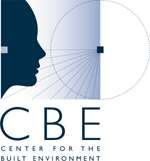Center for the Built Environment
The Center for the Built Environment (CBE) is a research center at the University of California, Berkeley. CBE's mission is to improve the environmental quality and energy efficiency of buildings by providing timely, unbiased information on building technologies and design techniques.[1] CBE's work is supported and guided by a consortium of building industry leaders, including manufacturers, building owners, contractors, architects, engineers, utilities, and government agencies[2]. The CBE also maintains an online newsletter of the center's latest activities called Centerline[3].

Overview
The Center for the Built Environment was founded in 1997 under the National Science Foundation Industry/University Cooperative Research Center (I/UCRC) program.[4] CBE is located in the Building Science Group at the College of Environmental Design at UC Berkeley. It is one of the largest university laboratories devoted to building research in the United States. Key facilities include a controlled environment chamber (designed to resemble a contemporary office, while allowing precise control over the levels of temperature, humidity, ventilation, and lighting in the space), and an extensive collection of portable equipment for acquiring and analyzing data from field experiments.
Research
CBE's research areas include 1) Indoor Environmental Quality (IEQ), 2) Building HVAC (Heating, Ventilation, Air Conditioning) Systems, 3) Building Envelope Systems, 4) Human Interactions, 5) Sustainability, Whole Building Energy, and Other Topics [5]. CBE provides information about its research areas and publications on its website [6]. More than 440 works by researchers affiliated with CBE are freely available to the public on the center's eScholarship page[7].
CBE's research program is guided by its Research Team and Advisory Board. The CBE Advisory Board includes manufacturers, building owners, facility managers, contractors, architects, engineers, government agencies and professional associations. The research team includes people from across UC Berkeley's campus, with both staff scientists and graduate students, as well as scientists from Lawrence Berkeley National Lab and visiting experts from industry and other research institutions.
Industry Consortium
The center partners with many public and private organizations including design firms, manufacturers, builders and government organizations, which together form an Industry Consortium and partially fund CBE research. The CBE maintains a list of current industry partners on its website [8].
Notable CBE partners (past and present) include:
Design Firms:
- Arup
- HOK
- SOM
- Stantec
- Integral Group
Manufacturers:
- Herman Miller
- Steelcase
- Haworth
- Carrier Corporation/UTRC
- Ingersoll Rand
- Armstrong World Industries
Governmental Organizations:
- National Science Foundation
- California Energy Commission
- California Department of General Services (DGS)
- U.S. Department of Energy,
- U.S. General Services Administration
- U.S. Department of Defense
Utilities:
References
- "Center for the Built Environment - About Us". Retrieved 2013-09-26.
- "Our Industry Partners". Center for the Built Environment. Retrieved 15 November 2017.
- "Centerline – Newsletter of the Center for the Built Environment at UC Berkeley". cbe.berkeley.edu. Retrieved 2017-11-16.
- "Center for the Built Environment - About Us". Retrieved 2013-09-26.
- "Center for the Built Environment: Research". www.cbe.berkeley.edu. Retrieved 2017-11-05.
- "Center for the Built Environment - Our Research Portfolio". www.cbe.berkeley.edu. Retrieved 2017-11-06.
- "eScholarship -Open Access Publications from the University of California - Center for the Built Environment". Retrieved 2017-11-15.
- "Industry Partners at CBE". www.cbe.berkeley.edu. Retrieved 2017-11-16.
External links
- Center for the Built Environment - The homepage for the organization
- CBE Thermal Comfort Tool- free web tool for ASHRAE 55
- CED Industry Partners - A comprehensive list of industry partners
- Lawrence Berkeley National Lab - The homepage of Lawrence Berkeley National Lab